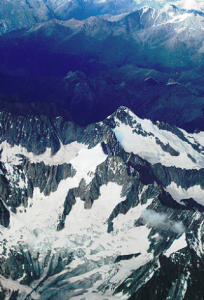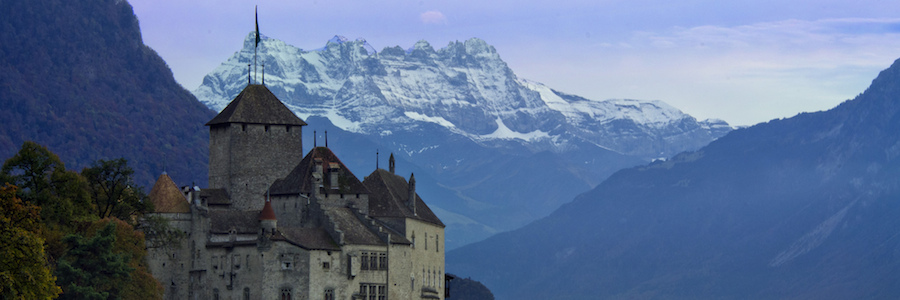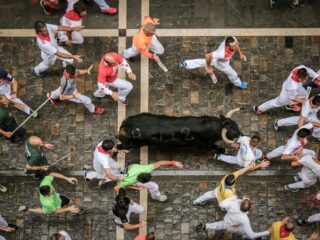
by Danielle Pearson,
When Mary Shelley looked at the Alps, she did not see mountains, lakes and trees. Instead, she saw an earthly paradise, a landscape so sublime that words could only hint at the wonder that it inspired. Writing of the mountains, Shelley draws attention to all that is measureless and eternal; “placed in scaleless altitude in the stainless sky, heaven kissing… the glorious Alps, clothed in dazzling robes of light.” These words are from her 1826 novel The Last Man, in which the Alps play a crucial role in the fate of humanity. But Shelley’s first visit to this stunning landscape had been back in 1814, when she was still Mary Godwin. Just sixteen years old at the time, she had eloped with the poet Percy Bysshe Shelley and traveled with him across Europe.
This was an incredibly scandalous move, the first in a lifetime of radical and independent behavior. Though very much in love, things were far from perfect for the couple—they couldn’t marry since Shelley already had an estranged wife, both families disapproved of the affair, and money ran out by the time they had reached Switzerland. Yet in the face of all this, the teenage Mary Godwin proved to be strong-willed, a free spirit full of very modern ideas. She was in love and traveling, both totally new experiences for her. All in all, it must have been an extraordinary journey, and for the rest of Mary’s life the Alps served as a wellspring of inspiration, playing a crucial role in her most famous works.
Fast forward two years, and the pair were once again in the Alps, this time sojourning on the shores of Lake Geneva. This of course was to be the most formative summer of Shelley’s life. The couple were staying with the poet Lord Byron, already infamous across Europe, along with Shelley’s step-sister Claire Clairmont and Byron’s physician Polodori. The group spent their summer reading, writing, boating on the lake, and having heated discussions late into the night. It’s probably fair to say that a certain amount of alcohol (and possibly narcotics) was involved, and rumors swirled around the group, many suggesting that they were practicing their own brand of “free love” behind closed doors. In this heady atmosphere, one of literature’s most ghastly creations took life. The proverbial dark and stormy night found the writers sitting around the fire sharing ghost stories, when Lord Byron challenged them to conjure the most frightening tale imaginable. The result, of course, was one of the great Gothic masterpieces of the 19th century; Frankenstein.
As the daughter of two important literary figures and the lover of a radical poet, Shelley had long harboured a desire to write, and now finally she was embarking on a serious literary project. Again, the trip was not one of perfect equilibrium, with sexual jealousies and other resentments brewing among members of the party. Yet regardless, Shelley was alive that summer, on the cusp of womanhood and her literary career. She later described her time in Switzerland as her coming-of-age moment, “when I first stepped out from childhood into life.” Surrounded by her literary peers in an idyllic mountainous landscape, Shelley was eager to prove herself their equal. And of course she did so. The Alpine scenery did not just inspire her most famous work—it wove itself into the very narrative of Frankenstein, providing the backdrop for the novel’s climactic finish. Frankenstein is full of thematic references to the Fall, and ponders the status of man in relation to God. In Shelley’s own life, the Alps functioned as a kind of Eden, a youthful paradise that witnessed the genesis of her writing career.
Percy and Mary Shelley finally married in 1816, and initially moved to Italy. But after six years of their nomadic lifestyle, Percy tragically drowned, and Shelley’s world fell apart. By now she had already suffered several miscarriages, and the death of two children. She returned to England with her remaining son Percy Florence, financially insecure and suffering from severe depression. Lord Byron died the following year, and Polidori had already committed suicide back in 1821. If the Alpine summer had been Shelley’s Eden, she now found herself cast out, old beyond her years and one of the last survivors of her literary circle.
In this mood of grief and isolation, Shelley began The Last Man. It is an extraordinary, disturbing book, a sprawling apocalyptic novel set in the late 2090’s. In it a plague slowly destroys all of humanity until only the narrator, Lionel Verney, remains. Despite its gothic subject matter, the book is painfully close to home, an exorcism of its author’s raw grief. The characters are modelled closely on Shelley’s own loved ones, with the idealistic Adrian representing Percy Shelley, and the adventurous Lord Raymond channeling Byron. Meanwhile, the narrator, that isolated figure with whom Shelley so clearly identifies, declares that for him, “Hope was madness… for life had married death.” If anyone could be described as wedded to death, it was Mary Shelley. Her mother had died giving birth to her, all but one of her own children were deceased or miscarried, and so many of her friends, including her husband, were lost to accidents and suicides. In 1823, Shelley sat down to write again with a horde of ghosts clustering around her desk.
And so The Last Man is an odd book, part glowing tribute to Percy Shelley and Lord Byron, part bleak rejection of the very Romantic ideals that they stood for. The Alps are the crucial lynchpin in all this. In the novel, the landscape of Shelley’s happiest memories becomes the focal point for the last men and women on earth. Stalked by plague in England, they feel a compulsion to wander eastwards, and begin a pilgrimage to the Alps. The scene that they imagine they will find is described in paradisaical terms, a land of “perpetual spring, fragrant groves and sparkling streams.” They even believe that the plague may die out if they can only reach the mountains, that perhaps “under the icy vaults of the glaciers, beneath the shadow of the pines… we should find health.”
This use of the Alps as a symbol of rejuvenation, or as a force that holds some compulsive sway on the human mind, was well established in the Romantic tradition. Many of the early poets, including Wordsworth, made their own pilgrimages to the Alps. Once there they described moments of transition, permanent changes in perception that were forged in the crossing of this epic mountain range. Percy Shelley also describes just this in his poem “Mont Blanc.” In it, he draws attention not only to the power and sublimity of the mountain, but also to himself, the way in which his imaginative mind responded to the experience. Shelley wanted, like Wordsworth, to put the Romantic individual at the center of the scene, to examine what it was that such natural wonders could catalyst in the human psyche.
well established in the Romantic tradition. Many of the early poets, including Wordsworth, made their own pilgrimages to the Alps. Once there they described moments of transition, permanent changes in perception that were forged in the crossing of this epic mountain range. Percy Shelley also describes just this in his poem “Mont Blanc.” In it, he draws attention not only to the power and sublimity of the mountain, but also to himself, the way in which his imaginative mind responded to the experience. Shelley wanted, like Wordsworth, to put the Romantic individual at the center of the scene, to examine what it was that such natural wonders could catalyst in the human psyche.
The Last Man on the other hand, offers a much bleaker reading of humanity’s place in nature. Percy Shelley’s “Mont Blanc” begins, “The everlasting universe of things/ Flows through the mind.” The Last Man seems to hinge on the directly opposite premise, that the individual human flows through the eternal landscape, but leaves no mark. As the plague ravages society in Shelley’s novel, nature looms in the background, beautiful yet indifferent. The individual doesn’t matter. We are erased and subsumed by the landscape as if we were never there to begin with, and the things which make us human—societal structures, arts, culture, religion—all fall away in the face of encroaching death. As Lionel despondently wonders, “did God create man, merely to become dead earth in the midst of vegetating nature?” The author’s brutal answer, in the face of her own grief, is a resounding yes. And so, when her last straggling survivors arrive in Switzerland, they do not find quite the paradise they were hoping for. The Alpine landscape they discover is undoubtedly beautiful, full of glassy lakes, plunging ravines, and towering glaciers. But it is empty, scattered with the same abandoned towns and overgrown fields, the same stench of death that they have encountered all over Europe.
The effort of the journey has caused almost every last human to perish, so that now only Lionel and his companions Adrian and Clara remain. Like a young Wordsworth, Lionel still sees these mountains as an emotional crossing point—”we regarded the Alps as boundaries between our former and our future states of existence.” He is right, but not in the way he imagines. At this point in the novel the plague finally ceases, and since Clara and Adrian are unrelated, the possibility of a future for humanity is still in the air. But the wanderers make the fatal decision to go on to Italy, and there, like Percy Shelley, both Clara and Adrian drown in a cruel and arbitrary twist of fate. Lionel is now the last surviving human, a crushingly lonely man on a desolate planet.
As you may have guessed, The Last Man is not the easiest of reads. It is the protracted cry of Mary Shelley’s grief, and is often unremittingly bleak. And yet. What has always fascinated me about the novel is that as the author meditated upon her loved ones and the places they visited together, she couldn’t help but to stumble onto moment of brightness, redemption even. Take the scene where the last few survivors round the crest of a Swiss hill, and looking out, see the Alps laid beneath them for the first time. Lionel is struck dumb, noting that for an instant, “Carried away by wonder, I forgot the death of man.” Meanwhile, another member of the group cries out, “God reveals his heaven to us, we may die blessed!” The Alps remain an earthly paradise in The Last Man after all. Even as they stand eternally indifferent to human suffering, their beauty is such that it does do something to alleviate the pain. How can this be? What stubborn human quality could have us gasping at the beauty of a mountain vista when the whole race of man has gone extinct? As Shelley pondered this question, she returned again and again, however reluctantly, to the conclusion that even if hope is madness, it is the most tenacious human quality. She found no way, in the end, to write a protagonist who could not hope. As Lionel says, even if he and his friends only had the freedom to choose where to die, they chose well. The Alps are after all, “a fitting costume to our last act.”
Lionel survives, and in the final pages of the novel, he sets out to scour the earth for other “last men.” He takes books with him, another hopeful gesture, noting that, “the principle are Homer and Shakespeare.” As Huxley’s Brave New World proved a century later, there is no better symbol of the human spirit (and none so portable in a harsh dystopian universe) than a volume of Shakespeare. Something essential about our humanity, it is suggested, has been preserved in our literature, even if the species seems to have vanished. And by writing the first person account, which constitutes the novel, Lionel is also making a leap of faith, an assumption that some fellow being will survive to find his testimony. Writing, in the end, constitutes the greatest act of hope of which the last man in capable.
And so Mary Shelley herself, in the very act of taking up her pen and writing The Last Man, undermined its bleak philosophy with her own gritty determination to survive and take care of her son. Just as for her protagonist, writing, it transpired, was the expression of her hope. In the following years, she was able to live by her pen as she had always intended, to continue the literary career that had begun deep in the Alpine landscape. She had Percy Florence well educated, and he grew to be a cheerful young man, reportedly very close to his mother. In the 1840’s, the two of them set out for Europe once again, on a continental tour—to the Alps.
Danielle Pearson is a writer and editor from the UK. Since graduating from Oxford University two years ago, she has been living in Istanbul and Berlin, where she has worked on various projects including articles, short stories, ghost writing and book editing.
Front page image by Kosala Bandara. Additional images by Yasser Alghofily.











